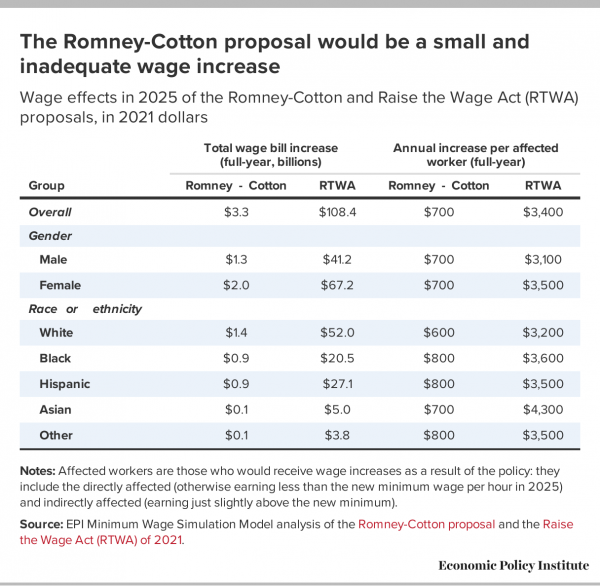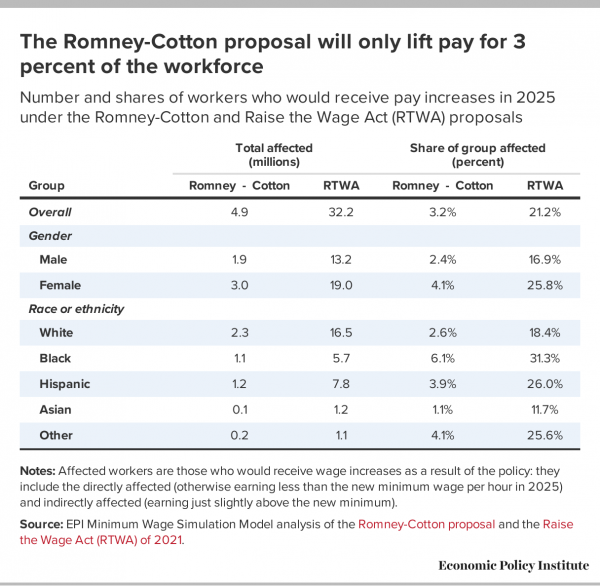https://www.epi.org/blog/romney-cotton-minimum-wage/
Those who had high hopes for a serious minimum wage proposal from the Republican Party will be disappointed: The recent proposal released by Sens. Mitt Romney (R-Utah) and Tom Cotton (R-Ark.) would not even increase the minimum wage to 1960s levels, after adjusting for inflation. It is a meager increase that fails to address the problem of low pay in the U.S. economy.
The Romney–Cotton proposal would slowly raise the federal minimum wage from its current level of $7.25 per hour to $10 per hour in 2025. In contrast, the Raise the Wage Act of 2021 would raise the minimum wage to $15 per hour by 2025.
- The Romney–Cotton proposal would leave 27.3 million workers without a pay increase, compared to the Raise the Wage Act.
- Only 4.9 million workers, or 3.2% of the workforce, would receive a pay increase in 2025 under the Romney–Cotton plan, for a total of $3.3 billion dollars in wage increases.
- In contrast, under the Raise the Wage Act, pay would rise for 32.2 million workers, or 21.2% of the workforce, with $108.4 billion in total wage increases.
- 11.2 million fewer Black and Hispanic workers would receive a raise under the Romney–Cotton plan, compared with the Raise the Wage Act.
- 16 million fewer women would see wage increases. Less than one in 20 women (4.1%) would have higher pay under the Romney–Cotton proposal, whereas the Raise the Wage Act would raise earnings for one in every four women (25.8%).
- The average affected worker who works year-round would see their annual pay rise by $700 under the Romney–Cotton plan; under the Raise the Wage Act, the average annual pay increase would be nearly five times that amount ($3,400).
Romney–Cotton's $10 target by 2025 is the equivalent of $9.19 per hour in today's dollars, about 13% less than what the minimum wage was at its high-water mark in 1968.
It is unconscionable that we should pay the lowest-wage workers today less than what they earned five decades ago, while the economy's productivity has more than doubled over the last 50 years. The Romney–Cotton proposal would continue that harmful trend; would maintain a separate lower wage for young workers and those with disabilities; and would—incredibly—fail to increase the separate minimum wage for tipped workers that has been stuck at $2.13 per hour for 30 years.
The Romney–Cotton plan would also couple this meager minimum wage increase with a nationwide mandate for employers to use E-Verify, the federal government's web-based electronic employment authorization system. This part of their proposal is a blatant attempt to scapegoat immigrants for the behavior of low-wage, low-road employers. E-Verify does not afford sufficient privacy and due process protections, giving employers an additional tool to discriminate and retaliate against workers when they speak up about workplace abuses, wage theft, and health and safety violations—or when they try to join with other workers in union-organizing efforts.
Without a broad immigration reform that legalizes the unauthorized immigrant population, a nationwide E-Verify mandate will push millions of working people into the informal economy, degrading wages and working conditions and undermining the freedom of association and ability of workers to join together to improve labor standards for all. It will also create additional incentives for employers to misclassify workers as independent contractors—already a disturbing trend in the U.S. economy—which will allow employers to distance themselves from responsibility for labor and employment violations.
In short, the Romney–Cotton plan would do little to improve the working conditions of the low-wage workforce. It compares especially poorly with the Raise the Wage Act of 2021, which raises the federal minimum to $15 by 2025 and gradually eliminates all subminimum wages. A single adult working full time today, in 2021, needs at least $15 an hour to maintain a modest but adequate standard of living in virtually every area of the country, according to the Economic Policy Institute's Family Budget Calculator. The Romney–Cotton proposal comes nowhere close to that level: Future automatic increases after 2025 would keep the Romney–Cotton minimum wage stalled at $10 per hour in real, inflation-adjusted terms; in nominal terms, it would be roughly $11.54 in 2030.
The tables below provide a detailed comparison of the impact of the Romney–Cotton plan and the Wage the Raise Act of 2021 on the low-wage workforce.


-- via my feedly newsfeed

No comments:
Post a Comment